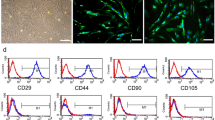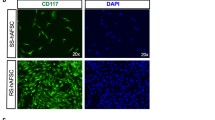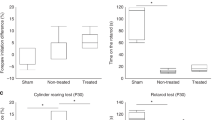Abstract
Although human amnion derived mesenchymal stem cells (AMSC) are a promising source of stem cells, their therapeutic potential for traumatic brain injury (TBI) has not been widely investigated. In this study, we evaluated the therapeutic potential of AMSC using a rat TBI model. AMSC were isolated from human amniotic membrane and characterized by flow cytometry. After induction, AMSC differentiated in vitro into neural stem-like cells (AM-NSC) that expressed higher levels of the neural stem cell markers, nestin, sox2 and musashi, in comparison to undifferentiated AMSC. Interestingly, the neurotrophic factors, brain-derived neurotrophic factor (BDNF), nerve growth factor (NGF), neurotrophin 3 (NT-3), glial cell derived neurotrophic factor (GDNF) and ciliary neurotrophic factor (CNTF) were markedly upregulated after neural stem cell induction. Following transplantation in a rat TBI model, significant improvements in neurological function, brain tissue morphology, and higher levels of BDNF, NGF, NT-3, GDNF and CNTF, were observed in the AM-NSC group compared with the AMSC and Matrigel groups. However, few grafted cells survived with minimal differentiation into neural-like cells. Together, our results suggest that transplantation of AM-NSC promotes functional rehabilitation of rats with TBI, with enhanced expression of neurotrophic factors a likely mechanistic pathway.






Similar content being viewed by others
References
Bruns J Jr, Hauser WA (2003) The epidemiology of traumatic brain injury: a review. Epilepsia 44(Suppl 10):2–10
Gogel S, Gubernator M, Minger SL (2011) Progress and prospects: stem cells and neurological diseases. Gene Ther 18:1–6
Kim HJ, Lee JH, Kim SH (2010) Therapeutic effects of human mesenchymal stem cells on traumatic brain injury in rats: secretion of neurotrophic factors and inhibition of apoptosis. J Neurotrauma 27:131–138
Poltavtseva RA, Silachev DN, Pavlovich SV, Kesova MI, Yarygin KN, Lupatov AY, Van’ko LV, Shuvalova MP, Sukhikh GT (2012) Neuroprotective effect of mesenchymal and neural stem and progenitor cells on sensorimotor recovery after brain injury. Bull Exp Biol Med 153:586–590
Riess P, Molcanyi M, Bentz K, Maegele M, Simanski C, Carlitscheck C, Schneider A, Hescheler J, Bouillon B, Schafer U, Neugebauer E (2007) Embryonic stem cell transplantation after experimental traumatic brain injury dramatically improves neurological outcome, but may cause tumors. J Neurotrauma 24:216–225
Wennersten A, Meier X, Holmin S, Wahlberg L, Mathiesen T (2004) Proliferation, migration, and differentiation of human neural stem/progenitor cells after transplantation into a rat model of traumatic brain injury. J Neurosurg 100:88–96
Soncini M, Vertua E, Gibelli L, Zorzi F, Denegri M, Albertini A, Wengler GS, Parolini O (2007) Isolation and characterization of mesenchymal cells from human fetal membranes. J Tissue Eng Regen Med 1:296–305
Tsuji H, Miyoshi S, Ikegami Y, Hida N, Asada H, Togashi I, Suzuki J, Satake M, Nakamizo H, Tanaka M, Mori T, Segawa K, Nishiyama N, Inoue J, Makino H, Miyado K, Ogawa S, Yoshimura Y, Umezawa A (2010) Xenografted human amniotic membrane-derived mesenchymal stem cells are immunologically tolerated and transdifferentiated into cardiomyocytes. Circ Res 106:1613–1623
Warrier S, Haridas N, Bhonde R (2012) Inherent propensity of amnion-derived mesenchymal stem cells towards endothelial lineage: vascularization from an avascular tissue. Placenta 33:850–858
Yen BL, Huang HI, Chien CC, Jui HY, Ko BS, Yao M, Shun CT, Yen ML, Lee MC, Chen YC (2005) Isolation of multipotent cells from human term placenta. Stem Cells 23:3–9
Fukuchi Y, Nakajima H, Sugiyama D, Hirose I, Kitamura T, Tsuji K (2004) Human placenta-derived cells have mesenchymal stem/progenitor cell potential. Stem Cells 22:649–658
Magatti M, De Munari S, Vertua E, Nassauto C, Albertini A, Wengler GS, Parolini O (2009) Amniotic mesenchymal tissue cells inhibit dendritic cell differentiation of peripheral blood and amnion resident monocytes. Cell Transplant 18:899–914
Fisher-Shoval Y, Barhum Y, Sadan O, Yust-Katz S, Ben-Zur T, Lev N, Benkler C, Hod M, Melamed E, Offen D (2012) Transplantation of placenta-derived mesenchymal stem cells in the EAE mouse model of MS. J Mol Neurosci 48:176–184
Tao J, Ji F, Liu B, Wang F, Dong F, Zhu Y (2012) Improvement of deficits by transplantation of lentiviral vector-modified human amniotic mesenchymal cells after cerebral ischemia in rats. Brain Res 1448:1–10
Hayase M, Kitada M, Wakao S, Itokazu Y, Nozaki K, Hashimoto N, Takagi Y, Dezawa M (2009) Committed neural progenitor cells derived from genetically modified bone marrow stromal cells ameliorate deficits in a rat model of stroke. J Cereb Blood Flow Metab 29:1409–1420
Zhang L, Zhang HT, Hong SQ, Ma X, Jiang XD, Xu RX (2009) Cografted Wharton’s jelly cells-derived neurospheres and BDNF promote functional recovery after rat spinal cord transection. Neurochem Res 34:2030–2039
Mahmood A, Lu D, Chopp M (2004) Intravenous administration of marrow stromal cells (MSCs) increases the expression of growth factors in rat brain after traumatic brain injury. J Neurotrauma 21:33–39
Hermann A, Gastl R, Liebau S, Popa MO, Fiedler J, Boehm BO, Maisel M, Lerche H, Schwarz J, Brenner R, Storch A (2004) Efficient generation of neural stem cell-like cells from adult human bone marrow stromal cells. J Cell Sci 117:4411–4422
Zhu R, Xu R, Jiang X, Cai Y, Zou Y, Du M, Qin L (2007) Expression profile of cancer-related genes in human adult bone marrow-derived neural stemlike cells highlights the need for tumorigenicity study. J Neurosci Res 85:3064–3070
Schmittgen TD, Livak KJ (2008) Analyzing real-time PCR data by the comparative C(T) method. Nat Protoc 3:1101–1108
Feeney DM, Boyeson MG, Linn RT, Murray HM, Dail WG (1981) Responses to cortical injury: I. Methodology and local effects of contusions in the rat. Brain Res 211:67–77
Paxinos G, Watson C (2005) The rat brain in stereotaxic coordinates coordinates, 5th edn. Elsevier Academic Press, San Diego, pp 98–123
Chen J, Sanberg PR, Li Y, Wang L, Lu M, Willing AE, Sanchez-Ramos J, Chopp M (2001) Intravenous administration of human umbilical cord blood reduces behavioral deficits after stroke in rats. Stroke 32:2682–2688
Hains BC, Saab CY, Lo AC, Waxman SG (2004) Sodium channel blockade with phenytoin protects spinal cord axons, enhances axonal conduction, and improves functional motor recovery after contusion SCI. Exp Neurol 188:365–377
Abercrombie M (1946) Estimation of nuclear population from microtome sections. Anat Rec 94:239–247
Chang YJ, Hwang SM, Tseng CP, Cheng FC, Huang SH, Hsu LF, Hsu LW, Tsai MS (2010) Isolation of mesenchymal stem cells with neurogenic potential from the mesoderm of the amniotic membrane. Cells Tissues Organs 192:93–105
Lendahl U, Zimmerman LB, McKay RD (1990) CNS stem cells express a new class of intermediate filament protein. Cell 60:585–595
Ellis P, Fagan BM, Magness ST, Hutton S, Taranova O, Hayashi S, McMahon A, Rao M, Pevny L (2004) SOX2, a persistent marker for multipotential neural stem cells derived from embryonic stem cells, the embryo or the adult. Dev Neurosci 26:148–165
Kaneko Y, Sakakibara S, Imai T, Suzuki A, Nakamura Y, Sawamoto K, Ogawa Y, Toyama Y, Miyata T, Okano H (2000) Musashi1: an evolutionally conserved marker for CNS progenitor cells including neural stem cells. Dev Neurosci 22:139–153
Qian DX, Zhang HT, Ma X, Jiang XD, Xu RX (2010) Comparison of the efficiencies of three neural induction protocols in human adipose stromal cells. Neurochem Res 35:572–579
Jiang J, Lv Z, Gu Y, Li J, Xu L, Xu W, Lu J, Xu J (2010) Adult rat mesenchymal stem cells differentiate into neuronal-like phenotype and express a variety of neuro-regulatory molecules in vitro. Neurosci Res 66:46–52
Yaghoobi MM, Mahani MT (2008) NGF and BDNF expression drop off in neurally differentiated bone marrow stromal stem cells. Brain Res 1203:26–31
Kaplan GB, Vasterling JJ, Vedak PC (2010) Brain-derived neurotrophic factor in traumatic brain injury, post-traumatic stress disorder, and their comorbid conditions: role in pathogenesis and treatment. Behav Pharmacol 21:427–437
Chen Q, Long Y, Yuan X, Zou L, Sun J, Chen S, Perez-Polo JR, Yang K (2005) Protective effects of bone marrow stromal cell transplantation in injured rodent brain: synthesis of neurotrophic factors. J Neurosci Res 80:611–619
Mocchetti I, Wrathall JR (1995) Neurotrophic factors in central nervous system trauma. J Neurotrauma 12:853–870
Gao J, Prough DS, McAdoo DJ, Grady JJ, Parsley MO, Ma L, Tarensenko YI, Wu P (2006) Transplantation of primed human fetal neural stem cells improves cognitive function in rats after traumatic brain injury. Exp Neurol 201:281–292
Lu P, Jones LL, Snyder EY, Tuszynski MH (2003) Neural stem cells constitutively secrete neurotrophic factors and promote extensive host axonal growth after spinal cord injury. Exp Neurol 181:115–129
Hong SQ, Zhang HT, You J, Zhang MY, Cai YQ, Jiang XD, Xu RX (2011) Comparison of transdifferentiated and untransdifferentiated human umbilical mesenchymal stem cells in rats after traumatic brain injury. Neurochem Res 36:2391–2400
Tsai MS, Hwang SM, Chen KD, Lee YS, Hsu LW, Chang YJ, Wang CN, Peng HH, Chang YL, Chao AS, Chang SD, Lee KD, Wang TH, Wang HS, Soong YK (2007) Functional network analysis of the transcriptomes of mesenchymal stem cells derived from amniotic fluid, amniotic membrane, cord blood, and bone marrow. Stem Cells 25:2511–2523
Zhang HT, Cheng HY, Cai YQ, Ma X, Liu WP, Yan ZJ, Jiang XD, Xu RX (2009) Comparison of adult neurospheres derived from different origins for treatment of rat spinal cord injury. Neurosci Lett 458:116–121
Nakajima K, Hida H, Shimano Y, Fujimoto I, Hashitani T, Kumazaki M, Sakurai T, Nishino H (2001) GDNF is a major component of trophic activity in DA-depleted striatum for survival and neurite extension of DAergic neurons. Brain Res 916:76–84
Acknowledgments
We thank Health & Biotech (Guangdong, Guangzhou, China) for their kindly presenting human amnion derived mesenchymal stem cells. This research was supported by the Natural Science Foundation of China (U0632008, 81100916).
Conflict of interest
The authors declare that they have no conflict of interest.
Author information
Authors and Affiliations
Corresponding author
Additional information
Zhong-Jie Yan and Peng Zhang contributed equally to this work.
Rights and permissions
About this article
Cite this article
Yan, ZJ., Zhang, P., Hu, YQ. et al. Neural Stem-Like Cells Derived from Human Amnion Tissue are Effective in Treating Traumatic Brain Injury in Rat. Neurochem Res 38, 1022–1033 (2013). https://doi.org/10.1007/s11064-013-1012-5
Received:
Revised:
Accepted:
Published:
Issue Date:
DOI: https://doi.org/10.1007/s11064-013-1012-5




